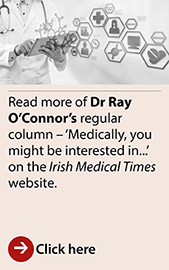Dr Ray O’Connor , 2025-05-07 07:30:00
Dr Ray O’Connor takes a look at the latest clinical articles on the importance of lifestyle advice in doctor-patient consultations
Lifestyle Update (Part 1)
I have a long-standing belief that we should include some lifestyle advice in most consultations. Over the last few months some interesting papers have been published which helps to update this advice. I will consider each briefly.
The first paper looked at physical activity (PA) advice in the General Practitioner (GP) consultation.1 The authors sought to explore the content of physical activity discussions during routine consultations between patients and GPs. This was a secondary analysis of video-recorded UK general practice consultations from the One in a Million study, which was conducted in the west of England.

Dr Ray O’Connor
In total, 294 consultation transcripts were available. The content, quality and depth of advice provided by GPs were scored to ascertain how meaningful the advice was. The findings were that PA was relevant to management according to clinical guidance in 175/294 (59.5 per cent) consultations.
In 64 (36.6 per cent) of these consultations, PA was discussed as part of clinical management; however, the depth of discussion was judged as ‘meaningful’ in only 22 (12.6 per cent) of consultations. Thus, there is a lot of scope for improvement in the use of PA advice in our consultations.
A literature review2 by colleagues from the Department of General Practice in the University of Limerick School of Medicine undertook a review the literature pertaining to factors that influence PA promotion in general practice, and to answer the research question: what are the experiences of patients and GPs with physical activity promotion in consultations? Of 464 papers retrieved, 20 were included in the review.
Their findings were that PA promotion is acceptable to patients, but some do not appreciate its health benefits. A personalised approach is important to patients, including tailored advice and setting meaningful goals. Studies involving GPs and practice nurses report that they are aware of the importance of PA and their role in its promotion, but time is the primary barrier. Strategies identified include de-medicalisation of PA, resources such as patient hand-outs as well as signposting to community initiatives, social prescribers and collaboration with exercise professionals.
What about PA advice for those suffering from Long Covid? This was the subject of a systematic review.3 Inclusion criteria were: (1) participants with long COVID; (2) random assignment to either an exercise intervention or a comparison group and (3) a quantitative measure of at least one of the 12 core long COVID outcomes. Eight studies were included.
Follow-up periods ranged from two to 28 weeks (mean=8.5 weeks). Sample sizes ranged from 39 to 119 (mean=56). All studies were in adults (mean age=49.9 years) and both sexes (mean female proportion=53.9 per cent). The authors concluded that exercise interventions lead to short-term improvements in dyspnoea, fatigue, physical function and the physical domain of quality of life among people with long COVID. Of the five studies that reported adverse events, rates were low and, when reported, mild. However, they also make the point that the evidence base consists of a limited number of studies with small sample sizes and short follow-up periods.
The association between leisure-time physical activity (LTPA) and a lower risk of mortality is susceptible to bias from multiple sources. The authors of this paper4 investigated the potential of biological ageing to mediate the association between long-term LTPA and mortality and whether the methods used to account for reverse causality affect the interpretation of this association. The study participants were twins from the older Finnish Twin Cohort (n = 22,750; 18–50 years at baseline).
 The authors identified four classes of long-term LTPA: sedentary, moderately active, active and highly-active. Although biological ageing was accelerated in sedentary and highly-active classes, after adjusting for other lifestyle-related factors, the associations mainly attenuated.
The authors identified four classes of long-term LTPA: sedentary, moderately active, active and highly-active. Although biological ageing was accelerated in sedentary and highly-active classes, after adjusting for other lifestyle-related factors, the associations mainly attenuated.
After accounting for familial factors and excluding participants reporting prevalent cardiovascular diseases, LTPA exhibited less favourable associations with mortality. The authors’ conclusion was that the association between LTPA and lower all-cause mortality may be largely due to genetic confounding and reverse causality. It should be pointed out here that this conclusion is at odds with a considerable body of published evidence.
A question that often comes up in the course of the consultation is ‘what are the risks of sudden death during PA?’ One way to answer this is to look at formal studies of long-distance running races.
More than 29 million participants completed marathons and half-marathons in the US between 2010-2023, approximately three times the number from 2000-2009. The objective of this study5 was to determine the incidence and outcomes of cardiac arrests during US marathons and half-marathons between 2010-2023 from a record of race-finishers, and a comprehensive review of cases from media reports, direct contact with race directors, USA Track & Field claims, and interviews with survivors or next-of-kin.
Their findings are very reassuring. Among 29,311,597 race finishers, 176 cardiac arrests (127 men, 19 women, 30 sex unknown) occurred during US long-distance running races.
Compared with 2000-2009, cardiac arrest incidence remained unchanged (incidence rate, 0.54 per 100,000 participants vs 0.60 per 100 000, respectively). However, there were significant declines in cardiac death incidence (0.20 per 100,000 vs 0.39 per 100,000) and case fatality rate (34 per cent vs 71 per cent).
Cardiac arrests remained more common among men (1.12 per 100,000) than women (0.19 per 100,000) and during the marathon (1.04 per 100,000), compared with the half-marathon (0.47 per 100,000). Among runners for which a definitive cause of cardiac arrest could be determined (n = 67/128 [52 per cent]), coronary artery disease rather than hypertrophic cardiomyopathy was the most common aetiology.
Decreased cardiopulmonary resuscitation time and an initial ventricular tachyarrhythmia rhythm were associated with survival. Thus the conclusion was that despite increased participation in US long-distance running races, cardiac arrest incidence remains stable. There has been a marked decline in cardiac arrest mortality.
References:
- Grice A et al. Discussions about physical activity in general practice: analysis of video-recorded consultations. Br J Gen Prac 2025; 75 (753): e277-e284. https://doi.org/10.3399/BJGP.2024.0166
- Dolan S. O’Regan A. How can physical activity promotion be optimised in general practice: a narrative review of the literature. Ir J Med Sci. 2025 Mar 21. https://doi.org/10.1007/s11845-025-03932-5
- McDowell C et al. Effectiveness and tolerance of exercise interventions for long COVID: a systematic review of randomised controlled trials. BMJ Open 2025;15:e082441. https://doi.org/10.1136/bmjopen-2023-082441
- Kankaanpaa A et al. The associations of long-term physical activity in adulthood with later biological ageing and all-cause mortality – a prospective twin study. European Journal of Epidemiology (2025) 40:107–122. https://doi.org/10.1007/s10654-024-01200-x
- Kim JH et al. Cardiac Arrest During Long-Distance Running Races. JAMA 2025. https://doi.org/10.1001/jama.2025.3026. Published online March 30, 2025.
